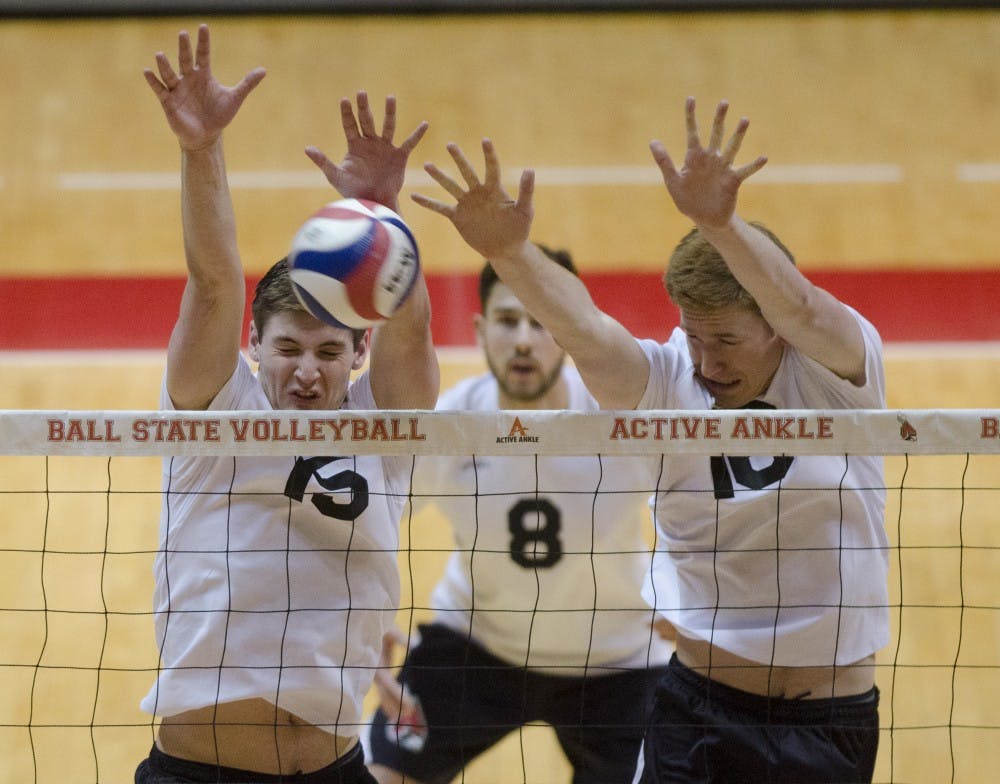Team blocking statistics
2014 – 2.59 blocks per set
2013 – 3.05 blocks per set
2012 – 2.72 blocks per set
2011 – 3.07 blocks per set
For years, Ball State has been one of the top blocking teams in the Midwest Intercollegiate Volleyball Association, often ranking first in the conference in blocks per set during previous seasons.
The men’s volleyball team takes pride in preventing opponents from getting the ball across the net, shutting down the offense before the ball has a chance to hit the floor.
“Blocking well starts before the ball is even served,” head coach Joel Walton said. “You’re looking at the other side to determine who’s most likely to get the ball and who the setter will give it to.”
This season, Ball State isn’t seeing the same level of blocking as it has in the past. Walton’s team ranks in the middle of the pack when it comes to blocks per set with 2.59. Lewis, Lindenwood and Loyola all rank ahead.
Part of the difference could be the losses of Jamion Hartley and Greg Herceg, two outside attackers who combined for nearly 100 blocks last season. Even without them, Ball State still has senior middle attackers Kevin Owens and Matt Leske.
The pair stands at 6-foot-9 and 6-foot-7, respectively, giving the Cardinals the size necessary to hinder opposing offenses.
To go along with the size, both players are agile and react quickly, offering redemption if a mistake is made.
“Leske is a little bit better with his movement along the net and he’s deceptively quick,” Walton said. “Both are persistent and recover well, they can jump late and still get blocks [and] they both work hard at fulfilling their responsibilities.”
Leske’s ability has earned him a No. 8 ranking in the MIVA in blocks per set with 1.06, and Owens is just behind at No. 11 with 0.94.
Owens credits prior experience and intuition as keys to his team’s success, and the team practices blocking often.
At practice, assistant coaches stand on blocks and fire practice attacks at the top of the net, while solo or double blockers practice leaping and knocking the ball back onto the other side of the court.
The drills teach proper technique in order to avoid injury to hands, wrists and fingers, injuries that Walton said are common.
During drills, the team uses practice balls called squishies. Made of foam and covered with a soft rubber, coaches use them instead of regulation volleyballs to increase player safety.
“We’ve seen when we’d hit a regular ball off a box, the blocker would either point his fingers toward the ball or lose his timing and his hands end up in an awkward position,” Walton said. “We’ve broken a lot of guys’ fingers.”
Assistant coach Kevin Furnish is one who knows that danger. During a practice, Furnish was hit by a middle attacker and broke his pinky finger.
Despite the risk, Owens and Leske know how valuable putting up a strong block is. Together, the duo each scored 21 solo blocks last season and had more than 100 block assists each, a key to Ball State’s 21-6 season.
“Primarily, you can score with your block right away,” Owens said. “It also allows the backcourt defense to set up and dig balls.”
A good block doesn’t necessarily have to reject the attack, but redirect it out-of-bounds or tool the block and into the waiting forearms of a defender.
To get there, players have to know where the attack will come from. A difficult task, defenders will watch the opposing setter’s eyes to see where he’s looking. Sometimes, the setter will accidently tip off where he’s sending the ball.
“You have to be able to read the setter and react to where he’s going so you can get in front of whoever’s attacking,” Leske said.
From there, it’s all technique.




